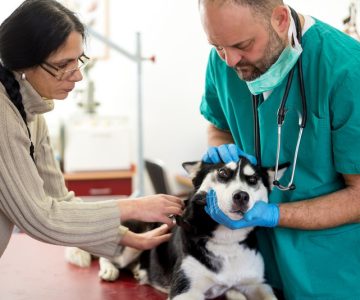How Top Vet Hospitals Use Advanced Radiology Techniques to Save Lives
How Top Vet Hospitals Use Advanced Radiology Techniques to Save Lives
When you hear “advanced radiology” and “lifesaving technologies,” you may naturally think of human healthcare. However, these revolutionary advancements are not just limited to the benefits they provide humans; they have also drastically changed the landscape of veterinary medicine. Animals, just like their human counterparts, can reap the rewards of these innovative diagnostic and treatment techniques that are transforming how top vet hospitals save lives.
Interventional Radiology (IR) in Veterinary Medicine
So, what is Interventional Radiology? In a nutshell, it refers to the use of imaging technology, such as fluoroscopy, to perform diagnostics and treatment procedures minimally invasively. By entering the body through natural orifices or blood vessels, there is no need for traditional surgery. This means less pain, faster recovery times, and improved quality of life for our four-legged friends.
Applications of Interventional Radiology in Top Vet Hospitals
Advanced radiology techniques have become increasingly popular across the veterinary field, with countless success stories proving their worth. Here are some critical examples of how Interventional Radiology transforms pet care at top vet hospitals:
Ureteral Obstruction Treatment
Did you know that ureteral obstructions are currently the leading cause of acute kidney failure in cats? When the tiny ureter tube that carries urine from the kidney to the bladder gets blocked – usually by a kidney stone – it can result in kidney damage and a dangerous accumulation of uremic toxins. Thankfully, IR techniques offer a far safer and more successful alternative to traditional surgery, with success rates between 80% and 95%.
Tracheal Collapse Treatment
In small-breed dogs, tracheal collapse is a common condition that narrows the airway, leading to coughing, exercise intolerance, and dangerous oxygen deprivation. Medications may work for some dogs, but what about those who don’t respond well? This is where Interventional Radiology steps in with tracheal stenting, a minimally invasive procedure that lets patients breathe easier and go home the same day.
Urethral Obstruction Treatment
Urethral obstruction affects dogs and cats and can become life-threatening if left untreated. In this condition, the urethra – the tube that carries urine out of the body – becomes blocked due to tumors in the bladder or the urethra itself. IR techniques such as urethral stenting can remove the obstruction quickly, allowing the patient to urinate freely and go home the same day.
Advanced Cancer Treatment Using Interventional Radiology
Traditional cancer treatments, like oral or injectable chemotherapy, are limited when targeting specific tumors and often have troubling side effects. Interventional Radiology presents a game-changer by delivering a targeted dose of chemotherapy directly to cancer, resulting in fewer side effects and a more effective treatment overall.
Treating Intrahepatic Portosystemic Shunts with Interventional Radiology
Portosystemic shunts are congenital abnormalities in which blood vessels bypass the liver instead of flowing into it. While surgery can be a viable option for extrahepatic shunts, intrahepatic shunts pose a more significant challenge due to their deep location within the liver. Employing IR techniques, such as transvenous coil embolization, significantly reduces the risks, complications, and recovery time associated with traditional surgery, leading to better long-term success for pets.
CT Scans and Their Role in Advanced Diagnostics
CT scans are another example of advanced radiology techniques in top vet hospitals, like those at Southwest Florida animal hospital. By providing detailed, 3D images of a pet’s internal organs, CT scans help veterinarians understand complex conditions better, enabling them to offer more accurate diagnoses and tailored treatment plans. In the grand scheme of things, this technology is not only minimizing uncertainty but also saving lives.
Exploring Dog Radiology
Dog radiology is essential to veterinary medicine, empowering vets with crucial diagnostic information. From detecting bone fractures to confirming the presence of tumors, radiology plays a vital role in identifying the underlying issue and providing the pet’s caregiver with much-needed answers. The more veterinarians understand a condition, the better they can plan practical action.
Surgery and Alternative Treatments
Sometimes, the best course of action is traditional surgery. However, advanced radiology techniques constantly offer new, minimally invasive alternatives that can be less risky for our pets. With the growing advancements in veterinary technology, veterinarians can now provide pet owners with more info on suitable treatment options and alternatives to surgery, ensuring each animal receives the most appropriate care for their specific condition.
Training and Expertise in Interventional Radiology at Top Vet Hospitals
Of course, the effectiveness of advanced radiology techniques relies on skilled professionals who can carry out these delicate procedures. Top vet hospitals invest in specialized training for their staff, ensuring they are well-versed in the latest technologies and Interventional Radiology techniques. These medical professionals are committed to leveraging cutting-edge technology to provide the best possible outcomes for their furry patients.
Embracing the Future of Veterinary Treatment
Interventional Radiology is undoubtedly a game-changer in veterinary medicine, providing lifesaving treatments and enhancing the quality of life for countless animals. It’s essential to recognize the importance of embracing and investing in innovative technologies as they continue to reshape the future of the veterinary landscape. Pet owners can rest assured that, as advances in radiology progress, their beloved pets will receive the absolute best care and treatment options modern veterinary medicine offers.
Conclusion
In conclusion, top vet hospitals are increasingly adopting advanced radiology techniques to save lives and improve the wellbeing of their patients. Armed with skilled professionals, state-of-the-art equipment, and cutting-edge technology, these hospitals demonstrate the tremendous impact of Interventional Radiology on the future of veterinary care. So when your pet faces a health challenge, you can take comfort in knowing that these innovative treatments are available to help your furry companion live a happy, healthy life.





